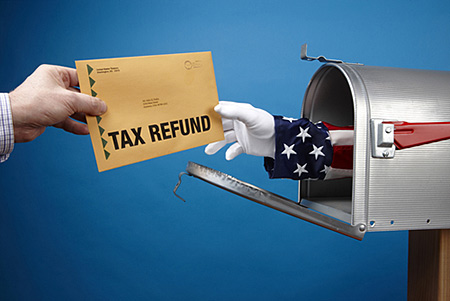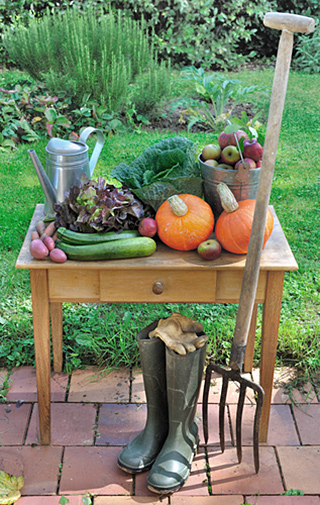|
In this issue:
The Six Smartest Ways to Spend Your Tax Refund
Eight Last-Minute Ways to Save for Vacation
Vegetable Garden Planning for Beginners
| The Six Smartest Ways to Spend Your Tax Refund |
| |
So you got a nice, big tax refund this year. Congrats! Now comes the difficult part: How should you spend it?
It's a decision that many Americans will have to make. In 2014, the Internal Revenue Service issued about 109.2 million refunds totaling $304 billion, with taxpayers receiving an average refund of $2,783. That's on par with refunds issued in 2013, which tallied an average of $2,744.
 Obviously, we're talking about a lot of money. And it's tempting to blow it all on an exotic vacation, designer clothes or a state-of-the-art home entertainment center. But you probably want to think twice about such plans. Obviously, we're talking about a lot of money. And it's tempting to blow it all on an exotic vacation, designer clothes or a state-of-the-art home entertainment center. But you probably want to think twice about such plans.
To help provide some guidance, we've spoken to several personal-finance professionals who offered these six wise ways to spend your refund:
1. Pay down that credit card balance. Financial experts universally rank paying down expensive debt at the top of the list of "smart tax-refund spending ideas." And guess where you're likely keeping your most costly debt? That's right: It's generated by that tiny piece of high-rate plastic in your wallet.
"By using proceeds from your tax refund to pay off that debt, you're reducing your interest," says Ryan S. Himmel, a certified public accountant (CPA) and president/CEO of BIDaWIZ Inc., an online marketplace for professional tax and financial advice and services. "If you think it's smarter to put money into the stock market, you'll need to earn 15% to 20% annually [equal to your card's interest rate] on those investments for that choice to make more sense."
2. Invest for a comfy retirement. Let's say you pay off your credit card bill every month. You can opt to invest all or part of your tax refund into your retirement portfolio, and you'll avoid even more taxes in the process.
"You can sock it away into an IRA - or make additional contributions to your work-based retirement plan - and reap the rewards of tax-deferred investing," Himmel says. "For many, a Roth IRA is very attractive. The principal grows tax-free, and there's no required minimum distribution during your lifetime as there is with a traditional IRA and work retirement plan."
3. Build a "rainy day" cushion. Personal-finance experts recommend that you keep no less than six months' worth of expenses in an emergency fund that's readily accessible vehicle, such as a savings account. Building up that cushion isn't exactly fun, but it's necessary in an unpredictable economy.
"No one likes to have an emergency fund - until you have an emergency," says Chris Reining, founder of MrEverydayDollar.com, a personal finance blog. "Establishing this will help you when there's a job loss, medical issue or an unexpected home or car repair. Ultimately, you'll thank yourself that you put aside those six months of expenses."
4. Keep it "in house." If you own your home, consider making an extra mortgage principal payment. "That brings down the effective cost of that debt," says Anna K. Pfaehler, a certified financial planner (CFP) and portfolio manager with Palisades Hudson Financial Group, a financial planning and investing firm.
However, there are downsides to this idea, especially if you have significant credit card debt, which typically has a higher interest rate than a mortgage. (See suggestion No. 1.)
5. Give it away. Donating all or part of the donation to charity isn't just the right thing to do; it's also a smart financial move. "Not only are you helping a good cause," Pfaehler says, "you're reducing your tax bill."
6. Have fun! OK, we don't want to be total buzz killers here. It's perfectly reasonable to enjoy spending a big refund. But maybe you should consider a tech toy or nice dinner as opposed to a luxury cruise or new car.
Should You Be Getting a Big Tax Refund Every Year?
Receiving a big ol' check from Uncle Sam can be viewed as a bad thing. Why? Because it represents an interest-free loan you've made to the U.S. government. Instead of withholding all of that cash from your paycheck, you could have been putting it to work by building your emergency fund, paying off debt and investing in your retirement.
To avoid excessive withholding and get more money back throughout the year, first discuss your W-4 form with a human- resources representative and/or a certified tax professional. "The number of personal allowances you have depends on your marriage status and dependents," Pfaehler says. "The fewer the number of allowances, the greater the withholding rate. If you consistently have a huge refund, you might have too few allowances."
However, you don't want to cut the withholdings too close. In fact, financial/investment expert Jim Morrison feels that all the fretting over the "giving the government an interest-free loan" thing is overstated.
"So what if you're giving the IRS that loan?" asks Morrison, who founded Morrison Financial Group. "At today's interest rates on savings accounts with a $3,000 tax refund, you're giving up literally just a couple of dollars a year. However, the tax penalties for under-withholding are severe. They also can result in the requirement to file quarterly tax estimates for years to come. All of which means that obsessing about withholding too much simply isn't worth the potential hassle."
Article courtesy of NEA Member Benefits
Back To Top
|
| Eight Last-Minute Ways to Save for Vacation |
| |
In a perfect world, we'd all have fully funded vacation accounts to pay for our annual family getaways. The reality: Most of us are just now starting to think about this summer's vacation. Here are some fast-track ways to save for your big trip.
 1. Start with a spending plan 1. Start with a spending plan
Decide upfront how much you'll spend on your vacation. Get specific. Along with plane tickets (or gas, if you're driving) and hotel prices, guesstimate costs for meals, souvenirs, and park or museum admissions. Total it all up. If the number sends you into shock, cut back on costs - now, on paper - until you feel comfortable with what you're spending. If money is really tight, consider a couple of long weekend trips instead of one "dream" vacation this summer.
2. Sacrifice now for fun later
Do you belong to a health club or subscribe to a service (such as cable or satellite TV, a cell phone plan, etc.) that you no longer use, or could easily downgrade? "Drop the service now and stash the money away for your family's summer vacation," says Kim Danger, founder of Mommysavers.com. Also consider cutting back for a few months on nonessentials like kids' dance lessons, your weekly Pilates classes, your husband's trips to the batting cage or your family's monthly movie-rental service.
Remember: You're just trading today's fun for the fun you'll have during your vacation. Move what you normally would have spent on these items into your vacation fund. Ideally, that would be a special savings account or an easy-to-track category within your larger savings account.
3. Build cash with a 'Pantry Week'
A typical family with kids younger than age 6 spends an average of $239 each month on restaurant meals, according to the National Restaurant Association. That's money that could easily be diverted to your vacation fund.
Some ways to cut back without going cold turkey: Check local restaurants for "kids eat free" nights (often Monday or Tuesday nights), watch newspaper coupon inserts for buy one entree, get one free dining deals or buy discounted coupons (usually $25 certificates for $10) at Restaurant.com.
Frozen dinners or ready-made grocery deli items are much cheaper than restaurant food if all you really need is a cooking break. You could also eat dinner inexpensively at home, then treat the family to a modest dessert out.
5. Make a savings wall chart
Kids are more likely to get excited, and you'll stay on track more easily, if you make your savings goal visual. Chart a graph on a large poster board. Track your weekly or monthly progress toward your trip savings with colorful markers and stickers.
Set some milestones along the way: For instance, once you've saved one-quarter of your trip costs, celebrate with a special movie-at-home night or go out for ice cream. Celebrating your success makes the savings process fun.
6. Sell your stuff
A garage sale is a great way to earn vacation cash from your castoffs. To attract a crowd, run an ad in your local newspaper and post easy-to-read signs around your neighborhood. Check local regulations about posting notices, of course, and write signs in crayon if it looks like rain.
Sales tips: Kids' clothes sell well at yard sales, adult clothes don't -- try a consignment shop instead. List kids' clothing sizes and brand names, if you have them, in your ad. Some parents make special trips to garage sales featuring labels like BabyGap and Gymboree, says Danger.
If your kids are old enough to help, let them pick some of their older toys to sell, suggests Dave Ramsey, author of "The Total Money Makeover." A special kids' table with a sign like, "All proceeds go to purchase of our Disneyland souvenirs," is often a big hit - and it's a great way to teach your kids about money.
7. Use your tax refund - now
Do you usually get an IRS refund in April? If so, too much tax money is being withheld from your paycheck. Fill out a new W-4 form with your employer right away. Adjust your tax withholding so that it's fairly close to what you will owe in April.
Your next paycheck should be substantially bigger. Start transferring the extra money into your dedicated vacation savings account or category. If you still get a refund this spring, sock it away, too. Heather Larson of Tacoma, Wash., puts her family's refunds into short-term certificates of deposit that expire right before their vacation. That way, they don't spend the money on anything else. You can locate the best rates in your area on Bankrate.com.
8. Let credit cards pay you back
In the months prior to your vacation, use a credit card that accumulates "rewards"(points or cash rebates) for everything you can: gas, groceries - even day-care tuition.
Let rewards pile up, then use them toward plane tickets (if you've been banking points/dollars for a while), hotel or rental car discount, or gift cards for chain restaurants you'll visit on your trip. You can locate and compare rewards cards at Bankrate.com. The key, of course, is to pay off your balance in full every month. Vacation debt is not the kind of souvenir you want to collect.
Article courtesy Bankrate.com
Back To Top
|
| Vegetable Garden Planning for Beginners |
| |
 Here's our quick guide for the beginner vegetable gardener. Whether you're a beginner or an old hand, planting in a pot or a plot, this advice will help you to plan and grow your tastiest vegetables ever. Here's our quick guide for the beginner vegetable gardener. Whether you're a beginner or an old hand, planting in a pot or a plot, this advice will help you to plan and grow your tastiest vegetables ever.
Why garden? If you've never tasted garden-fresh vegetables (lots of people haven't!), you will be amazed by the sweet, juicy flavors and vibrant textures. There's absolutely nothing like them, especially if you grow the vegetables yourself - and you can!
We'll highlight the basics of vegetable garden planning: how to pick the right site, figure out how "big" to go, and how to select which vegetables to grow.
Start Small!
Remember this: It's better to be proud of a small garden than to be frustrated by a big one!
One of the common errors for beginners is planting too much too soon and way more than anybody could eat or want. Unless you want to have zucchini taking up residence in your attic, plan carefully. Start small.
Start Smart
- Plant in a sunny location. Vegetables need at least 6 hours of direct sunlight per day. The more sunlight they receive, the greater the harvest and the better the taste.
- Plant in good soil. Plants' roots penetrate soft soil easily, so you need nice loamy soil. Enriching your soil with compost provides needed nutrients. Proper drainage will ensure that water neither collects on top nor drains away too quickly.
- Space your crops properly. For example, corn needs a lot of space and can overshadow shorter vegetables. Plants set too close together compete for sunlight, water, and nutrition and fail to mature. Pay attention to the spacing guidance on seed packets and plant tabs.
- Buy high-quality seeds. Seed packets are less expensive than individual plants. If seeds don't germinate, your money - and time - are wasted. A few "extra" cents spent in spring for that year's seeds will pay off in higher yields at harvest time.
Deciding How Big
A good-size beginner vegetable garden is about 16x10 feet and features crops that are easy to grow. A plot this size, based on the vegetables suggested below, can feed a family of four for one summer, with a little extra for canning and freezing (or giving away).
Make your garden 11 rows wide, with each row 10 feet long. The rows should run north and south to take full advantage of the sun.
Vegetables that may yield more than one crop per season are beans, beets, carrots, cabbage, kohlrabi, lettuce, radishes, rutabagas, spinach, and turnips.
Suggested Plants for 11 Rows
The vegetables suggested below are common, productive plants but you'll also want to contract your local cooperative extension to determine what plants grow best in your local area. Think about what you like to eat as well as what's difficult to find in a grocery store or farmers' market.
- Tomatoes - 5 plants staked
- Zucchini squash - 4 plants
- Peppers - 6 plants
- Cabbage
- Bush beans
- Lettuce, leaf and/or Bibb
- Beets
- Carrots
- Chard
- Radishes
- Marigolds to discourage rabbits!
When to Plant?
Know when to plant what. See our Best Planting Dates chart - a gardening calendar customized to your local frost dates - covering both sowing indoors as well as planting in the ground.
Article courtesy of Almanac.com
Back To Top
|
|

 Obviously, we're talking about a lot of money. And it's tempting to blow it all on an exotic vacation, designer clothes or a state-of-the-art home entertainment center. But you probably want to think twice about such plans.
Obviously, we're talking about a lot of money. And it's tempting to blow it all on an exotic vacation, designer clothes or a state-of-the-art home entertainment center. But you probably want to think twice about such plans. 1. Start with a spending plan
1. Start with a spending plan Here's our quick guide for the beginner vegetable gardener. Whether you're a beginner or an old hand, planting in a pot or a plot, this advice will help you to plan and grow your tastiest vegetables ever.
Here's our quick guide for the beginner vegetable gardener. Whether you're a beginner or an old hand, planting in a pot or a plot, this advice will help you to plan and grow your tastiest vegetables ever.